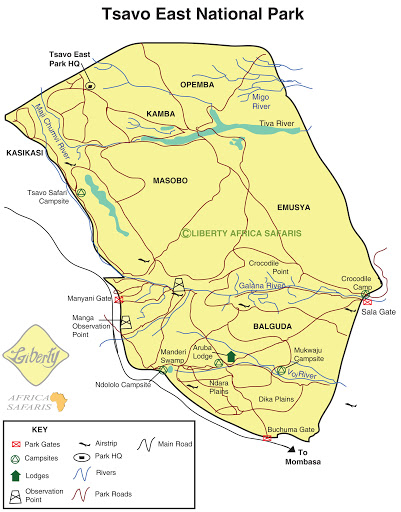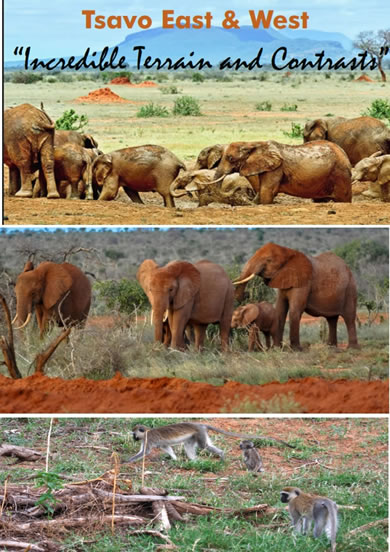Tsavo East National Park & Ngutuni Sanctuary



Fact File: Tsavo East National Park
Tsavo East National Park is by far the biggest of Kenya’s parks. At more than 13,700km², Tsavo East is 9x bigger than the Maasai Mara National Reserve. Most famous for its huge herds of dust-red elephants, more than 10,000 of them bulldoze their way around this vast park. Tsavo East has an offbeat streak because it is possible to set out for a game drive and see no other vehicle elsewhere. There are few camps and lodges here and relatively speaking almost none since most of them are found close to Voi near the Mombasa Highway.
All safaris in this park take place south of the Galana River in wide flat open spaces, scattered bush and red soil
Tsavo East National Park
Overview
Tsavo East is one of the oldest and largest national parks in Kenya at 13,747 square kilometers, situated in a semi-arid area previously known as the Taru desert, it was opened in April 1948, and is located near the town of Voi in the Taita-Taveta County of the former coast province. The park is divided into east and west sections by the A109 road and a railway. Named for the Tsavo River, which ows west to east through the national parks, it borders the Chyulu Hills National Park and the Mkomazi Game Reserve in Tanzania.
The early Victorian colonists from Britain saw Tsavo East as a problem area to be fought against: they couldn’t farm there, but they were going to make sure their trains ran on time on the new railway line. Having dealt with two man-eating lions (the 'Man-Eaters of Tsavo') after losing dozens of labourers to the hungry pair during the railway’s construction, they were determined to avoid staff shortages over wildlife. Tsavo East’s dense population of black rhinos was considered to be a particular scourge, making footpaths and roads unsafe for pedestrians. As late as the years after World War II, the British employed the suitably and a man named JA wiped out 1088 rhinos over the course of a year in the area that is now Tsavo East National Park.
The plant communities of Tsavo East are dominated by short grasses, thorn bushes and two major species of tree. The baobab is the iconic tree of Tsavo West National Park, across the Mombasa highway, but you still find significant numbers of these compelling trees, with their enormous trunks and stumpy branches. They form important habitats for many species of birds and insects: you’ll often seen hornbills using holes in baobabs to nest in. The doum palm is a curious tree, a native of North Africa, with edible dates and kernels, whose southernmost territory is the Galana River. When young, the trees are a mass of bushy fronds, but as they mature and the trunks grow, they bifurcate, sometimes two or three times, to create an arresting
visual image of forked palm trees.
Animals to spot here with great (nearly 100%) success include the dominant elephants, lion, eland, oryx, gerenuk, giraffes, spotted hyena, zebra, hippos, buffalo and with luck, the leopard, cheetah and striped hyena
Tsavo East / Ngutuni Safari Experience
Extended Game Drives
Be ready to explore and explore. The expansive park provides an opportunity to experience Africa's lost wilderness and its game. With parked lunches, set out early and return to the camp at dusk. Ensure that you view some of Tsavo East's treasured landmarks
Mudanda Rock is an Ayer’s Rock-like sandstone inselberg whose bare flanks form a natural water catchment area that feeds into a large, seasonal lake, attracting large numbers of animals.
The Yatta Plateau is a 300km ancient lava flow that stretches along the east and north bank of the Athi-Galana. Its geomagnetic qualities are believed to play a role in guiding migratory birds and large numbers of Palearctic migrants can be seen in the area.
Lugard Falls are a series of short falls and steep rapids on the Galana River, where relatively harder rock has created a bottleneck in the valley and impedes the river’s progress.
Crocodile Point is a place where the big reptiles can often be seen basking in the sun, is just downstream from here. At some point on most Tsavo East safaris, you're almost bound to stop here to stretch your legs and takes photos.
Sightings of short-maned Tsavo lions and cheetahs are common; all the plains grazers and bush browsers are much in evidence; and those elephants keep appearing in droves with their big tusks surging across the rivers and wallowing in the waterholes and occassionally filing over the red earth roads in front of bulging baobab trees.
Recommended Camps
Satao, Galdessa and Kulalu camps. Ngutuni Lodge.
Ngutuni Sanctuary
Ngutuni sanctuary is a 10,000 acre private game sanctuary, surrounded on three sides by Tsavo East National Park. With excellent views of the Sagala Hills and others nearby, Ngutuni sanctuary and the surrounding national park is best known today for their fantastic variety of wildlife including lion, cheetah, elephant, buffalo as well as a huge variety of plains game and bird life. It is only in Ngutuni Sanctuary, in the whole of Tsavo East National Park, where one can do a night game drive conveniently and spot a lot of animals including many big cats at very close range.
To Malindi for a Beach Extension
We recommend a beach extension to Malindi & Watamu from Tsavo. The park's Sala Gate to the far east side of the park and the well paved by-pass is boon to road travellers. Guests can return by air from Malindi International Airport to Nairobi or Mombasa.




